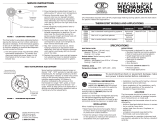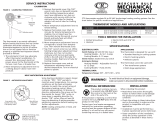Honeywell EASY-TO-SEE T841B User manual
- Category
- Household fans
- Type
- User manual

® U.S. Registered Trademark
Copyright © 2003 Honeywell International Inc. • • All Rights Reserved
INSTALLATION INSTRUCTIONS
69-1043-2
TRADELINE®
T841A,B Easy-To-See™
Heat Pump Thermostat
APPLICATION
The T841A, B Easy-to-See™ Heat Pump Thermostat
provides 24 Vac control of 2-stage heating and 1-stage
cooling in heat pump systems, using manual change-
over.
The T841A Thermostat provides EM. HT.-HEAT-OFF-
COOL System switching and AUTO-ON Fan switching.
The T841B Thermostat provides HEAT-OFF-COOL
System switching and AUTO-ON Fan switching.
The side of the thermostat features raised numbers for
easy temperature setting by touch or sight. An audible
click is heard with indents every two degrees as the
temperature setpoint lever is moved. The thermostat
wallplate features raised letters to aid in setting System
switch and Fan switch settings. See Fig. 1.
The T841A,B includes a thermostat and wallplate.
Test holes are provided on the front of the thermostat to
accommodate test meter probes without removing the
thermostat from the wall. Remove the cover of the
thermostat to expose the test holes that are labeled to
correspond with the terminals on the thermostat back.
OPERATION
The stages of heat make sequentially as the temperature
drops. Make refers to the mercury switch initiating a call
for heat or cool.
There is about 1°F (0.6°C) between stages so the
second stage (auxiliary heat) makes only when the first
stage cannot handle the load. This °F is the interstage
differential.
For T841A Thermostat only (not for T841B Thermostat):
light emitting diode (LED) indicators light when
something specific happens within the system:
When AUX. HT. green or amber LED lights, auxiliary
heat (second stage heat) is operating because the
weather is so cold, the heat pump alone cannot
handle the load.
When red EM. HT. LED lights, emergency heat is
operating (electric strip heaters), because home-
owner physically switched to EM. HT. position. See
heating/cooling manufacturer instructions.
MERCURY NOTICE
This control contains mercury in a sealed tube.
Do not place the control in the trash at the end of
its useful life. If this control is replacing a control
that contains mercury in a sealed tube, do not
place your old control in the trash.
Contract your local waste management authority
for instructions regarding recycling and the
proper disposal of this control, or of an old control
containing mercury in a sealed tube.
INSTALLATION
When Installing this Product...
1. Read these instructions carefully. Failure to follow
them could damage the product or cause a hazard-
ous condition.
2. Check the ratings given in the instructions and on
the product to make sure the product is suitable for
your application.
3. Installer must be a trained, experienced technician.
4. After installation is complete, check out product
operation as provided in these instructions.
CAUTION
Electrical Hazard.
Can cause Disconnect electrical shock or
equipment damage.
Disconnect power before beginning installation.
IMPORTANT
— To prevent interference with the thermostat link-
age, keep wire length to a minimum and run
wires as close as possible to the thermostat
base.
— Do not short across coil terminals on the relay.
This can burn out thermostat heat anticipator.
— Never install more than one wire per terminal
unless a factory-supplied jumper with a spade
terminal is used.

HEAT PUMP THERMOSTAT
69-1043-2 2
Location
Locate the thermostat between 4 ft (1.2m) and 5 ft (1.5m)
above the floor in an area with good air circulation at
average room temperature.
NOTE: Because of height restrictions of some disabled
users, it may be necessary to lower the thermo-
stat location to 4 ft (1.2m) above the floor.
Do not install thermostat where it can be affected by:
— drafts, or dead spots behind doors and in corners.
— hot or cold air from ducts.
— radiant heat from sun, appliances or fireplaces.
— concealed pipes and chimneys.
— unheated (uncooled) areas such as an outside wall
behind the thermostat.
This thermostat is a precision instrument and was
carefully adjusted at the factory. Handle it carefully.
Mounting
The T841A,B can be mounted directly on a wall or a
horizontal outlet box. Choose the method that best fits
your installation. In replacement applications, check the
existing thermostat wires for cracked or frayed insulation.
Replace any wires in poor condition.
To remove the thermostat cover:
1. Grasp thermostat cover at the top and bottom with
one hand.
2. Pull outward on the bottom edge of the cover until
it snaps free of the thermostat base.
3. Carefully remove and save the packing material
surrounding the mercury switches.
Wiring
All wiring must comply with local codes and ordinances.
Follow equipment manufacturer wiring instructions when
available.
NOTE: Four screws are provided with the thermostat;
only two are required for mounting.
1. Run wiring (if necessary) to the location. If wiring is
plastered into the wall, make a hole next to the wire
and loosen the wires so they can be pushed back
into the wall later.
2. Thread the wires through the hole.
3. Pull the wires through the entrance hole on the
wallplate.
4. Connect the wires to the terminals on the back of
the thermostat. See Fig. 1-3.
5. Push the excess wire back through the hole and
plug any openings with packing material to prevent
drafts that can affect thermostat performance.
6. Use two of the four screws provided to loosely
secure the thermostat and the wallplate to the wall
or outlet box through the two middle mounting
holes. See Fig. 1.
NOTE: The sheet metal screws included with the ther-
mostat are designed for use in plaster walls that
do not need anchors.
IMPORTANT
An incorrectly leveled thermostat causes inac-
curate temperature control.
7. Exactly level the thermostat using a spirit level or
plumb line.
8. Tighten the screws in the middle mounting holes.
9. Replace the thermostat cover.
Fig. 1. Mounting thermostat to wallplate (T841A model shown).
80
70
60
50
WALLPLATE
T841 BASE
MOUNTING
SCREWS (2)
T841 COVER
M11427
TEMPERATURE
SETPOINT LEVER
EH H O C
A O
SETPOINT
SCALE
EM. HEAT
LED
AUX. HEAT
LED
FAN SWITCH
SYSTEM SWITCH
MOUNTING
HOLES (4)
WIRING TERMINAL
(UP TO 12)
BACK OF DEVICE
HEAT PUMP THERMOSTAT
EM. HEAT HEAT OFF COOL
AUTO ON
FAN

HEAT PUMP THERMOSTAT
3 69-1043-2
Fig. 2. Internal schematic and typical wiring diagram for T841A with AUX. HT. and EM. HT. LEDs. Provides heat
or cool changeover relay control and automatic fan in emergency heat mode.
Fig. 3. Internal schematic and typical wiring diagram for T841B 2-stage heat, 1-stage cool, manual changeover.
L1
(HOT)
L
2
1
POWER SUPPLY. PROVIDE DISCONNECT MEANS AND OVERLOAD PROTECTION AS REQUIRED.
REMOVE W1-Y1 JUMPER WHEN HEAT RELAY 1 IS USED.
WHEN L TERMINAL IS CONNECTED TO SYSTEM MONITOR, EM. HEAT LED ALSO INDICATES COMPRESSOR MALFUNCTION.
X TERMINAL MUST BE CONNECTED FOR PROPER OPERATION.
1
2
3
4
H2 ANTICIPATOR
H2
FALL
H1
C1
FALL
H1 ANTICIPATOR
C1 ANTICIPATOR
SYSTEM
SWITCH
HEAT
OFF
COOL
FAN SWITCH
AUTO
ON
EM. HT.
COMPRESSOR
CONTACTOR
FAN RELAY
EM. HT.
RELAY
EM. HT.
LED (RED)
CHANGEOVER
RELAY (HEAT)
AUX. HT.
LED (GREEN)
HEAT RELAY 1
CHANGEOVER
RELAY (COOL)
AUX. HT.
RELAY
JUMPER
SYSTEM
MONITOR
O
L
G
R
E
X
W2
B
W1
Y1
3
4
2
M1103
E
H2
FALL
H1
FALL
C1
L1
(HO
T)
L2
1
1
POWER SUPPLY. PROVIDE DISCONNECT MEANS AND OVERLOAD PROTECTION AS REQUIRED.
H1/C1
ANTICIPATOR
H2 ANTICIPATOR
SYSTEM
SWITCH
COOL
OFF
HEAT
COOL CHANGEOVER VALVE
COMPRESSOR
CONTACTOR
FAN RELAY
HEAT CHANGEOVER
VALVE
HEAT RELAY 1
HEAT RELAY 2
FAN SWITCH
AUTO
ON
M6068A
W1
W2
B
G
R
X
Y1
O

69-1043-2 G.H. Rev. 3-03 www.honeywell.com/yourhome
HEAT PUMP THERMOSTAT
Printed in U.S.A. on recycled
paper containing at least 10%
post-consumer paper fibers.
Automation and Control Solutions
Honeywell International Inc. Honeywell Limited-Honeywell Limitée
1985 Douglas Drive North 35 Dynamic Drive
Golden Valley, MN 55422 Scarborough, Ontario
M1V 4Z9
SETTINGS
Temperature Setting
The enlarged, raised numbers on the right edge of the
thermostat can be used for easy temperature setting by
touch or sight while moving the temperature setpoint
lever to the desired temperature setting. The large 5, 6, 7
and 8 refer to 50°F (10°C), 60°F (16°C), 70°F (21°C) and
80°F (27°C), respectively. A click is heard with indents
every two degrees as the temperature setpoint lever is
moved. See Fig. 1.
System Switch Setting
The enlarged, raised letters on the left bottom edge of the
wallplate can be used for easy recognition of System
switch settings:
For the T841A Thermostat: The large EH, H, O and C
refer to EM. HT., HEAT, OFF and COOL.
For the T841B Thermostat: The large H, O and C refer
to EM. HT., HEAT, OFF and COOL.
The System switch settings control the system operation
as follows:
EM.HT (only on T841A): Emergency heat relay is
energized. Cooling system is off. Compressor is
de-energized. Fan runs on call for heat if the Fan
switch is in the AUTO position. EM. HT. LED is on.
HEAT: Heating system is automatically controlled by
the thermostat. Cooling system is off.
OFF: Both the heating and cooling systems are off. If
the fan is set to the AUTO position, the cooling fan
is also off.
COOL: Cooling system is automatically controlled by
the thermostat. Heating system is off.
Fan Switch Setting
On theT841A,B, large A, O raised letters on the right
bottom edge of the wallplate refer to AUTO and ON fan
settings. The Fan switch settings control the fan as
follows:
AUTO: Fan operates in response to thermostat in both
heating and cooling.
ON: Fan operates continuously.
CHECKOUT
Heating
Move the System switch on the thermostat to HEAT and
the Fan switch to AUTO. Move the temperature setpoint
lever to about 10°F (6°C) above the room temperature.
Heating should start and the fan should run. Move the
setpoint lever about 10°F (6°C) below the room
temperature. Heating and fan should shut off.
IMPORTANT
To prevent compressor short cycling, a mini-
mum-off timer can be included to prevent the
compressor from starting for up to five minutes
from when the thermostat last turned off the
compressor, or from when the system first
received power.
Cooling
CAUTION
Compressor Damage Hazard.
Operating cooling equipment in cold weather
can damage compressor.
Do not operate air conditioner if outdoor
temperature is below 50°F (10°C).
Move the System switch on the thermostat to COOL and
the Fan switch to AUTO. Move the temperature setpoint
lever about 10°F (6°C) below the room temperature.
Cooling and fan should start (see Note in Checkout
section). Move the setpoint lever about 10°F (6°C) above
the room temperature. Cooling and fan should shut off.
Fan
Move System switch to OFF, and Fan switch to ON. The
fan should run continuously. Move Fan switch to AUTO.
In this position, the fan operates in response to the
thermostat in both heating and cooling.
-
 1
1
-
 2
2
-
 3
3
-
 4
4
Honeywell EASY-TO-SEE T841B User manual
- Category
- Household fans
- Type
- User manual
Ask a question and I''ll find the answer in the document
Finding information in a document is now easier with AI
Related papers
-
Honeywell T841A1498 User manual
-
Honeywell T8095A User manual
-
Honeywell T8190A User manual
-
Honeywell Q682B User manual
-
Honeywell T8090A User manual
-
Honeywell T8424C User manual
-
Honeywell Thermostat CT3451 User manual
-
Honeywell CT3550 User manual
-
Honeywell CT3500/CT3595 User manual
-
Honeywell CT3500 User manual





